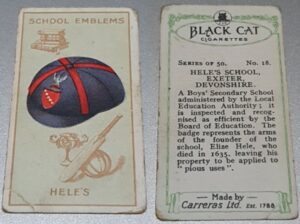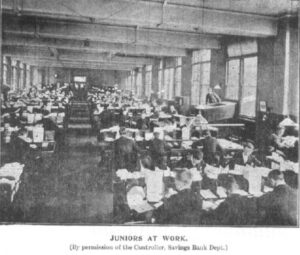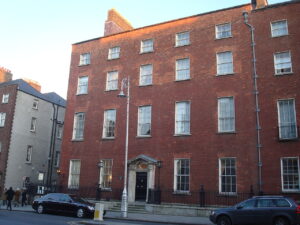Second Lieutenant Charles Anthony Victor Jeeves MM
The Devonshire Regiment attached 1/9th Bn, The Kings (Liverpool Regiment), 165th Brigade, 55th Division, B.E.F.

Malvern Commemoration: Holy Trinity North Malvern
Burial/Commemoration: Tyne Cot Memorial
Nature of Death: Died of wounds Battle of Menin Road Ridge, Flanders 20/9/1917
Age: 37
Next of Kin: The elder surviving son of Anthony Jeeves of Croyland, Albert Park Road, Malvern and the late May Lambert
Education: Hele's School, Exeter
Previous Employment: Civil Servant - Clerk in the Irish Land Commission, Dublin.
Early years
Charles Anthony Victor Jeeves, was born in Exeter on 29 May 1880, the son of Anthony and May Lambert Jeeves. They had him christened at St David’s Church in the on 18th June 1880. He appears to have been known as Victor.
In April the following year, the 1881 Census found the Jeeves family living at The Terrace, Staplegrove, and Victor’s father’s profession was given as “traveller” – the 1901 Census elaborates on this, recording him as a “Commission Agent for Cattle Medicines”. In 1882, the family were living in Taunton, Somerset, where Victor’s younger brother Leonard was born. The Jeeves boys all attended Hele’s School, Exeter.
The Jeeves family
Sadly Mary Jeeves died in 1888; Victor’s father re-married Amelia Jackson Briggs the following year. By 1891, the Jeeves family were living back in St David’s parish, Exeter at 147 St David’s Hill, where they remained for at least another ten years.
Tragedy struck the family again when Victor’s older brother Horace died in 1901 aged 26. Horace had gone blind at the age of 20 and had been living with his aunt’s farm in Manningford Abbots, Wiltshire. By 1911, Victor’s father and step-mother had retired and was at “Croyland”, 25 Albert Park Road, Malvern Link.
A career in the Civil Service
After leaving Hele’s School in 1897, Victor was appointed a “Boy Copyist [2]” in the Civil Service. In 1874 Queen Victoria had signed an order authorising the employment of Boy Clerks in the Civil Service. In 1886, an order closed the regime of the Men Copyists, and authorising the employment of Boy Clerks to the utmost extent in their place. This had an enormous effect upon the Boy Clerks in the Service, who entered at the rate of a thousand a year.
At the end of his boy service, Victor passed the necessary exams to remain in the Civil Service and, in November 1899 was appointed as an Assistant Clerk and Abstractor at the Admiralty. The 1901 Census recorded him still working in this appointment and boarding with other civil servants at 75 Ronalds Road, Islington.
A move over the Irish Sea
Victor was appointed as an Assistant Clerk (Abstractor) in the Irish Land Commission [4] in February 1907. On the 1911 Irish Census, enumerated as Victor, he was to be found boarding at 6 Churchill Terrace, Pembroke East, Dublin; he was recorded as a clerk at this stage.
First World War
When war broke out, Victor was still living at 55 Moyne Road, Dublin and joined a Chums company of the 7th Royal Dublin Fusiliers [6]. With this unit he landed at Gallipoli on 9th August 1915, and fought here until the RDF were transferred to the Salonika front in November 1915. He was wounded in Salonika shortly afterwards.
In September 1916, as a Lance Corporal, Victor was again wounded while trying to get a mortally wounded Major to safety. For his bravery on that occasion he was awarded the Military Medal [7].
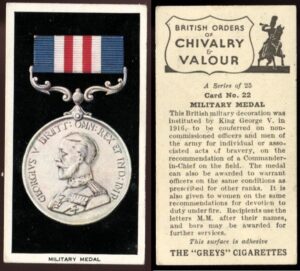 [8]
[8]The Military Medal, a gallantry medal for non-commissioned officers and men instituted in 1916. Illustrated here from a Grey’s cigarette card.
A commission
Charles was selected for officer training, and probably owing to his Devon roots requested to be commissioned into the Devonshire Regiment. He was granted this commission on 26th June 1917, but went to France attached to the 1/9th Liverpool Regiment [9] (9KLR). On arrival at his new battalion he was posted to ‘C’ Company.
Battle of the Menin Road Ridge
This battle sometimes called the “Battle of the Menin Road”, was the third attack of the Third Battle of Ypres [10]. It took place from 20th to 25th September 1917, in the Ypres Salient [11] and saw a change in infantry tactics. Waves of infantry [12] stopped once they reached their objective and consolidated the ground, while supporting waves passed through the objective to attack the next one and the earlier waves became the tactical reserve.
Victor’s battalion, part of the 55th (West Lancashire) Division were to take part in this attack on the northern side of operations. To finish the capture of the line from Schuler Farm to Langemarck and then advance 500–800 yards east towards Poelcappelle. The large numbers of strong points, pillboxes and fortified farms east of the Hanebeek and Steenbeek streams were mostly intact, despite numerous attempts to smash them with artillery fire.
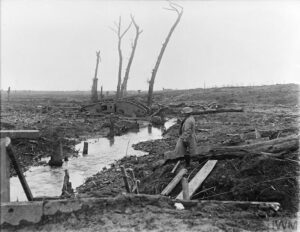 [13]
[13]A soldier look across devastated country near Ypres showing a derelict Mark IV Tank, shell-splintered trees and general battle detritus, 15 February 1918. Copyright: © IWM. Q 10711
The Kingsmen’s role
The 55th Division were under strength, following losses at the opening of the offensive on 31st July. The 9KLR advanced at 5.40am, with each company forming a successive wave. Victor’s company (C Company) formed the third wave.
Mist worked to the Germans’ advantage in this part of the front, because the depleted British units missed several German strong points and dugouts, from which the Germans were able to stop the British support waves from moving up. The advanced troops realising this either halted or turned back and lost the barrage. However with the arrival of reinforcements from the 1/6th Kings Liverpool Regiment, further progress was made.
Reserves were pushed forward around 10:00 a.m. from the 166th Brigade, which allowed the 165th and 164th Brigades, including the 9KLR, to take the first objective around Gallipoli Farm and the Schuler Galleries in front of Schuler Farm, by noon. Fighting at Hill 35 continued and the Germans regained Hill 37 with a counter-attack. Machine-guns were placed in the Schuler Galleries and nine machine-guns were dug in near Keir Farm, with which the British stopped German counter-attacks from making further progress.
In the afternoon the rest of the reserve brigade captured Hills 35 and 37, which dominated the Zonnebeke spur. The right of the division established touch with the 9th (Scottish) Division but the centre and left of 55th (West Lancashire) Division were 500 yd (460 m) short of the final objective.
Counting the cost
However this success came at a cost to the 9KLR. Over this and the two following days fighting – four officers and 26 other ranks were killed; 2 officers and 5 other ranks died of wounds; 8 officers and 190 other ranks were wounded and 44 other ranks were posted as missing. All three of the subalterns in C Company became casualties; Victor Jeeves among them.
A sympathetic letter from his commanding officer Lieut-Colonel F M Drew was received by his parents:
“Although he had only lately joined this Battalion he gave every promise of turning out an excellent officer, and needless to state, I am very sorry to lose him, especially as he was a tried man and had done such good work in the past.”
In reporting his death, the Dublin Evening Herald noted that Victor was the 23rd member of the Irish Land Commission to be killed in the war.
Commemoration
Victor’s body was not recovered, or if it was it was not identified after the war and today he is commemorated on the Tyne Cot Memorial [14].
In addition to his commemoration at North Malvern, Victor is also commemorated on the Heleans School [16] War Memorial (now located in St Peter’s Church of England Aided School [17]). This memorial, in its original site, was unveiled in May 1922.
He is also remembered in Dublin, on the Irish Land Commission Memorial, located in the former headquarters of the Commission at Mornington House [19], Upper Merrion Street, Dublin City Centre.
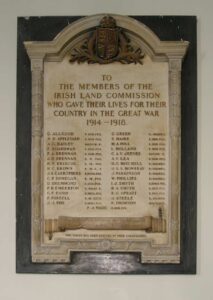 [20]
[20]The Irish Land Commission War Memorial at Mornington House, Upper Merrion Street, Dublin (Irish War Memorials website)
Postscript
Victor’s youngest brother Leonard, was ordained in priest in the Church of England in London Diocese in 1911 and served as a curate in Whitechapel. During the war he served as an Army Chaplain and in 1919 was appointed Rector of St John’s Cathedral, Newfoundland [21]. He held this post for ten years before returning to Broad Blunsden as Rector in 1929. He died in Malvern in 1956.
St David's Exeter, Baptism Register
1881 Census
1891 Census
1901 Census
1911 Census
1911 Census of Ireland
London Gazette 29/6/1897, 1/12/1899
Medal Index Card and 1915 Star Roll Public Record Office: WO 329
Army List November 1914
England & Wales, National Probate Calendar (Index of Wills and Administrations), 1858-1995
Malvern News 13/10/1917
Dublin Evening Herald 19/10/1917
Western Times 25/5/1922
http://studymore.org.uk/arce1872.htm
http://www.irishwarmemorials.ie/
Wikipedia
Article printed from Malvern Remembers: https://www.malvernremembers.org.uk
URL to article: https://www.malvernremembers.org.uk/ww1-profiles/charles-anthony-victor-jeeves
URLs in this post:
[1] Image: https://www.malvernremembers.org.uk/wp-content/uploads/2015/02/Heles-School.jpg
[2] Boy Copyist: https://hansard.parliament.uk/Commons/1901-06-17/debates/d30f630b-daa5-4cfc-9945-a4c365d30614/BoyCopyistsInTheCivilService
[3] Image: https://www.malvernremembers.org.uk/wp-content/uploads/2015/02/Boy-copyists.jpg
[4] Irish Land Commission: https://en.wikipedia.org/wiki/Irish_Land_Commission
[5] Image: https://www.malvernremembers.org.uk/wp-content/uploads/2015/02/MorningtonHouse.jpg
[6] Royal Dublin Fusiliers: http://en.wikipedia.org/wiki/Royal_Dublin_Fusiliers
[7] Military Medal: https://en.wikipedia.org/wiki/Military_Medal
[8] Image: https://www.malvernremembers.org.uk/wp-content/uploads/2015/02/MM.jpg
[9] Liverpool Regiment: http://en.wikipedia.org/wiki/King%27s_Regiment_%28Liverpool%29
[10] Third Battle of Ypres: https://en.wikipedia.org/wiki/Battle_of_Passchendaele
[11] Ypres Salient: https://en.wikipedia.org/wiki/Ypres_Salient
[12] infantry: https://en.wikipedia.org/wiki/Infantry
[13] Image: https://www.malvernremembers.org.uk/wp-content/uploads/2015/02/Steenbeek-in-1918-with-tank-Q-10711.jpg
[14] Tyne Cot Memorial: https://www.cwgc.org/visit-us/find-cemeteries-memorials/cemetery-details/85900/tyne-cot-memorial/
[15] Image: https://www.malvernremembers.org.uk/wp-content/uploads/2015/02/DSC03915-scaled.jpg
[16] Heleans School: https://en.wikipedia.org/wiki/Hele%27s_School,_Exeter
[17] St Peter’s Church of England Aided School: https://en.wikipedia.org/wiki/St_Peter%27s_Church_of_England_Aided_School
[18] Image: https://www.malvernremembers.org.uk/wp-content/uploads/2015/02/Hele-War-Memorial.jpg
[19] Mornington House: https://en.wikipedia.org/wiki/Mornington_House
[20] Image: https://www.malvernremembers.org.uk/wp-content/uploads/2015/02/Irish-Land-Commission-Memorial.jpg
[21] St John’s Cathedral, Newfoundland: https://en.wikipedia.org/wiki/Cathedral_of_St._John_the_Baptist_(St._John%27s)
Click here to print.
